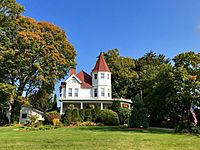Fennville, Michigan facts for kids
Quick facts for kids
Fennville, Michigan
|
|
|---|---|
|
Top to bottom, left to right:
Main Street/M-89 facing West, historic grain silos, the Kingsley House |
|

Location of Fennville, Michigan
|
|
| Country | United States |
| State | Michigan |
| County | Allegan |
| Area | |
| • Total | 1.10 sq mi (2.85 km2) |
| • Land | 1.09 sq mi (2.83 km2) |
| • Water | 0.01 sq mi (0.03 km2) |
| Elevation | 666 ft (203 m) |
| Population
(2020)
|
|
| • Total | 1,745 |
| • Density | 1,599.45/sq mi (617.30/km2) |
| Time zone | UTC-5 (Eastern (EST)) |
| • Summer (DST) | UTC-4 (EDT) |
| ZIP code |
49408
|
| Area code(s) | 269 |
| FIPS code | 26-27740 |
| GNIS feature ID | 1626274 |
Fennville is a small city in Allegan County, located in the state of Michigan in the United States. In 2020, about 1,745 people lived there.
Fennville is situated on M-89, a main road. It's about 11 miles (18 km) southeast of Saugatuck and 13 miles (21 km) west-northwest of Allegan. The city is also roughly 40 miles (64 km) southwest of Grand Rapids, a much larger city.
Contents
History of Fennville
How Fennville Got Its Name
The city of Fennville got its name from an early settler named Elam Atwater Fenn. He built a saw mill in the area. Because of his mill, people started calling the settlement "Fenn's Mill." This name was also used for the local post office. Sometimes, it was even called "Fenn's Mills." The very first road through what would become Fennville was built in 1837 by Harrison Hutchins and James McCormick.
A New Name and a Fire
In October 1871, a big fire destroyed the village. Around the same time, the new Chicago and Michigan Lake Shore Railroad was completed. The railroad's documents listed the community's station as "Fennville." Some people thought this was a mistake. However, Elam Fenn himself said that community leaders had agreed to change the name to match the new train station. After this, the post office also changed its name to "Fennville." The community officially became a village on February 20, 1889.
Sometimes, the name was written as two words, "Fenn Ville," or even "Fennsville" in older records.
Geography of Fennville
Fennville is a small city in terms of its size. According to the United States Census Bureau, the city covers a total area of about 1.11 square miles (2.87 square kilometers). Most of this area, about 1.10 square miles (2.85 square kilometers), is land. Only a very small part, about 0.01 square miles (0.03 square kilometers), is water.
Population of Fennville
| Historical population | |||
|---|---|---|---|
| Census | Pop. | %± | |
| 1890 | 360 | — | |
| 1900 | 454 | 26.1% | |
| 1910 | 533 | 17.4% | |
| 1920 | 547 | 2.6% | |
| 1930 | 622 | 13.7% | |
| 1940 | 643 | 3.4% | |
| 1950 | 639 | −0.6% | |
| 1960 | 705 | 10.3% | |
| 1970 | 811 | 15.0% | |
| 1980 | 934 | 15.2% | |
| 1990 | 1,023 | 9.5% | |
| 2000 | 1,459 | 42.6% | |
| 2010 | 1,398 | −4.2% | |
| 2020 | 1,745 | 24.8% | |
| U.S. Decennial Census | |||
Population Details
In 2010, there were 1,398 people living in Fennville. The city had 505 households. About 34.9% of the people living in Fennville were under 18 years old. About 7.7% were 65 years or older. The population was almost evenly split between males (50.3%) and females (49.7%).
Education in Fennville
Fennville has its own school district called Fennville Public Schools. This district includes several schools for different age groups:
- Fennville High School (for grades 9-12)
- Fennville Middle School (for grades 6-8)
- Fennville Elementary School (for grades K-5)
- Pearl Alternative/Adult Education School (for grades 9-12)
There was also a public school called Discovery Elementary School, but it closed at the end of the 2009 school year.
Fun Things to Do in Fennville
Goose Festival
Every October since 1984, Fennville hosts a special event called the Goose Festival. This festival celebrates the many Canada geese that fly through the area during their yearly migration. Thousands of geese pass by the nearby Todd Farm Unit of the Allegan State Game Area. The festival was partly started to encourage people to visit Fennville by train. Tens of thousands of visitors come to this small town each year to enjoy the activities and attractions. Volunteers organize and manage the Goose Festival.
Local Wine
Fennville and the area around it are known for making Michigan wine. This region is called the Fennville AVA, which stands for American Viticultural Area. This means the area has special conditions that are great for growing grapes and making wine. This also makes Fennville a popular place for tourists who enjoy visiting wineries.
Famous People from Fennville
Some notable people have come from Fennville:
- Patricia L. Birkholz - She served as a Michigan State Senator.
- Edward Hutchinson - He was a United States Representative for Michigan's 4th Congressional District from 1963 to 1977.
Images for kids
See also
 In Spanish: Fennville (Míchigan) para niños
In Spanish: Fennville (Míchigan) para niños





